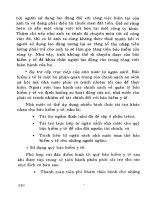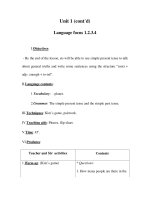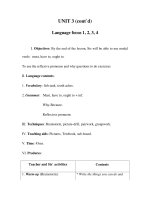3 4 2 regions and resources
Bạn đang xem bản rút gọn của tài liệu. Xem và tải ngay bản đầy đủ của tài liệu tại đây (3.26 MB, 10 trang )
Fascinating Facts
Regions and
Resources
• Most Americans use nearly seven hundred
pounds of paper each year.
• Thirty-nine percent of things put in landfills are
made of paper and could have been recycled.
• It takes between five hundred and one thousand
years for just one inch of rich soil to form.
Genre
Nonfiction
Comprehension Skill
Draw Conclusions
Text Features
•
•
•
•
Captions
Headings/Subheadings
Map
Time Line
Scott Foresman Social Studies
ISBN 0-328-14829-6
ì<(sk$m)=beicjf< +^-Ä-U-Ä-U
by Barbara Bigelow
In this book you will read about some of the regions
and natural resources in the United States. Read
on to find out more about the resources that are
beneath the earth’s surface!
Regions
and
Write to It!
What naturalResources
resources are near where you live?
How are they important to your community?
Write one paragraph about your ideas.
Vocabulary
natural resources
region
Write your paragraph on a separate sheet
of paper.
physical environment
landform
climate
fuel
mineral
communities
Illustration
3 ©Guy Porfirio
Photographs
by Barbara Bigelow
Every effort has been made to secure permission and provide appropriate credit for photographic material. The publisher deeply
regrets any omission and pledges to correct errors called to its attention in subsequent editions.
Unless otherwise acknowledged, all photographs are the property of Scott Foresman, a division of Pearson Education.
Photo locators denoted as follows: Top (T), Center (C), Bottom (B), Left (L), Right (R) Background (Bkgd)
ISBN: 0-328-14829-6
Copyright © Pearson Education, Inc.
All Rights Reserved. Printed in the United States of America. This publication is protected
by Copyright, and permission should be obtained from the publisher prior to any prohibited
reproduction, storage in a retrieval system, or transmission in any form by any means,
electronic, mechanical, photocopying, recording, or likewise. For information regarding
permission(s), write to: Permissions Department, Scott Foresman, 1900 East Lake Avenue,
Glenview, Illinois 60025.
1 2 3 4 5 6 7 8 9 10 V0G1 14 13 12 11 10 09 08 07 06 05
Opener: (C) ©David Muench/Corbis, (Bkgd) ©Digital Vision
2 ©Gary Vestal/Getty Images
4 (B) ©David Muench/Corbis, (T) ©Getty Images
5 ©Corbis
6 ©Peter Adams/Getty Images
Editorial Offices: Glenview, Illinois • Parsippany, New Jersey • New York, New York
7 ©David R. Frazier Photolibrary, Inc./Alamy Images
8 ©Tom Myers
Sales Offices: Needham, Massachusetts • Duluth, Georgia • Glenview, Illinois
9 ©The Granger Collection,
NY
Coppell,
Texas • Sacramento, California • Mesa, Arizona
10 ©Royalty-Free/Corbis
13 ©Peter Skinner/Photo Researchers, Inc.
Five Regions in One Country
Trees are a natural resource.
What is a natural resource?
Nature is truly amazing. Just take a look around
you. Almost everything you see started out as a
natural resource. Natural resources are useful
materials that come from the earth.
The toothpaste you used this morning contains sand.
Sand is a natural resource. The paper this book was
printed on came from a tree. Our forests are natural
resources. The gasoline that powers the car or the bus
you ride in started out as oil. Oil is a natural resource.
How about cars? Cars are made from natural
resources too. Car bodies are formed from sheets of
steel. Steel is made mostly of iron, which is found in
rock. Iron is an important natural resource.
2
The United States is the fourth-largest country in
the world. It is big enough to be divided into five
different regions. A region is a large land area that
has special features.
The five regions of the United States have very
different physical environments. You can tell one
type of physical environment from another by
observing its landforms and its climate. Landform
is a scientific word for the different shapes found
on Earth’s surface. Deserts and mountains are two
examples of landforms. Climate refers to the kind of
weather a place has from year to year.
This map shows the five regions of the United States.
West region
Northeast region
Midwest region
Southwest region
Southeast region
3
Check This Out
Did you know that the first
letters of the four directions on
a map—North, East, West, and
South—spell the word NEWS?
The five regions of the United States look very
different. You will find mountains in the West and
flat plains in the Midwest. The Southwest is very
hot and dry all year round. The Northeast can get
very cold and snowy during the winter. The South is
warmer than some other regions.
This is an oil well.
This is a hot, dry climate in
the Southwest region.
Where is that from?
Natural resources come from nature. The five
regions of the United States have very different
resources in their soil, rocks, and waters. Let’s look at
a few states and their natural resources.
Texas is a very large state in the Southwest. It is
famous for its oil. Oil is a natural resource that is
found beneath the ground. It comes from wells, or
deep holes in Earth’s surface. We use oil for fuel. Fuels
provide us with heat, light, and other forms of energy.
5
Midwestern states, such as Wisconsin, have cows and livestock.
You probably already know how valuable our forests
are. They provide homes for animals and oxygen for
us to breathe. They shade us from the Sun.
Trees are also important to the building industry.
Lumber comes from trees. It is wood that has been
cut into boards. Wood from trees is also used to make
paper and furniture.
You might be surprised at some of the other things
that are made from trees. Medicines, fabrics, bowling
balls, football helmets, hairspray, paints, tires, cough
drops, and gum all come from trees.
The best thing about trees, though, is that they
can be replaced by planting new ones. That makes
them a renewable resource. If we are careful, they will
never disappear!
The state of Wisconsin is in our nation’s Midwest.
This state has lots of cows, farmland, and trees.
Wisconsin is known for its dairy products, such as milk
and cheese. This state also produces the most paper
in our country.
Idaho is a state in the Northwest. Much of its land
is used for farming. Idaho is famous throughout the
world for its plentiful potato crops. The soil in Idaho is
good for growing wheat and trees.
Many potato
crops are grown
in Idaho.
6
Gold is a very valuable mineral. A mineral is a
natural resource that has never been alive. Gold
was first discovered in California back in 1848. This
discovery caused thousands of people to move out
west. The big westward movement became known as
the Gold Rush.
Can you dig it?
Gold is usually found buried in rock. Sometimes it is
mixed with loose soil. People panned for gold in the
Old West by swirling water from muddy streams in
pans to help separate the tiny gold flecks from the dirt.
Later, people dug deep holes called gold mines
in the earth to search for larger chunks of gold. A
miner’s job was to get the nuggets, or chunks of gold,
out of the mine.
Miners panned for gold.
Many of the people who took part in the Gold
Rush wanted to find some gold for themselves. Others
followed the crowd looking for different kinds of work.
Let’s see what might have happened out west in
1849 after gold was discovered. Many people traveled
far to look for gold, but there were other jobs to do.
The Miner Forty-Niners
Thousands of people headed west hoping
to find gold nuggets such as these.
8
The gold miners were nicknamed “forty-niners”
because the busiest year for gold mining in
California was 1849. Between the discovery of gold
in 1848 and the end of the Gold Rush in 1850,
about eighty thousand people moved to California.
9
The miners had to buy supplies, so some people set
up stores to sell things. The miners had to eat, so other
people grew food, cooked, or set up places for miners
to buy meals. The miners might get injured or sick, so
doctors were needed. People were able to find many
things to do even if they were not looking for gold!
Then what happened?
Not many gold miners got rich. By 1850 the Gold
Rush was over. A lot of miners decided to go back to
the states they came from. Some of the mining towns
were deserted. They became known as “ghost towns”
after everyone left.
Some people ended up staying in the area, though.
Many of them took up farming and communities
were formed. A community is a place where people
live, work, and have fun together. California became
this country’s thirty-first state at the end of 1850.
Some mines were in
the mountains.
10
11
How did fuels get under
the ground?
Oil, coal, and natural gas are fuels. We burn them to
produce heat, electricity, and other forms of energy.
All of these fuels were formed millions of years ago
and are buried in the ground.
You are probably wondering how all that oil, coal,
and natural gas ended up getting stuck under tons
of rock.
Let’s take a look at how oil forms. Coal and natural
gas form almost the same way.
Oil is sometimes called
“black gold” because it is such
a valuable natural resource.
12
A Fuel Time Line
1839
1973
The first steam shovel
is invented. This
invention makes it much
easier to dig coal from
the ground.
The price of oil goes way up
in the United States. People
have to wait in lines for
hours at gas stations to fill
up their gas tanks.
1839
1930s
Lots of oil is found
in Texas.
1859
1930s
1997
2004
1859
1997
America’s first oil field is
drilled in Pennsylvania.
The gas-electric hybrid car is
introduced in Japan. It can run
on gas or electricity.
How Oil Is Formed
Suppose it is three hundred million years ago, even
before the dinosaurs roamed Earth. Billions of tiny
plants and animals were living in Earth’s oceans.
When these ocean creatures died and sank to the
bottom of the water, they formed a muddy layer. Over
time, the plant and animal bodies were buried under
more and more layers of mud. It got pretty hot under
there, and the mud turned to rock. Much later, those
dead plants and animals turned into thick, gooey oil.
14
1973
2004
Scientists predict
that plankton,
sunflowers, and
bananas may be the
fuels of the future.
Will our natural resources
last forever?
Not every natural resource is like a tree. After a tree
is cut down, a new one can be planted in its place.
That is why forests are called renewable resources!
Unfortunately, oil, coal, and natural gas are not
like that. Once we find and use all the oil, coal, and
natural gas in Earth’s crust, they will be gone forever.
We cannot “plant” new supplies. That is why it is so
important to conserve our resources.
15
In this book you will read about some of the regions
Glossary
and natural resources in the United States. Read
climate the kind of weather a place has from year
on to find out more about the resources that are
to year
beneath the earth’s surface!
communities places where people live, work, and
have fun together
fuel a resource thatVocabulary
can be used to produce light,
natural
resources
heat, or other forms
of energy
region
landform a shape or part
of the earth’s surface, such
Write to It!
What natural resources are near where you live?
How are they important to your community?
Write one paragraph about your ideas.
Write your paragraph on a separate sheet
of paper.
environment
as a mountainphysical
or a desert
landform
mineral a natural resource
that has never been alive
climate
natural resources useful
materials that come from
fuel
the earth
physical environment mineral
a region’s landforms
and climate
communities
region a large land area that has special features
Illustration
3 ©Guy Porfirio
Photographs
Every effort has been made to secure permission and provide appropriate credit for photographic material. The publisher deeply
regrets any omission and pledges to correct errors called to its attention in subsequent editions.
Unless otherwise acknowledged, all photographs are the property of Scott Foresman, a division of Pearson Education.
Photo locators denoted as follows: Top (T), Center (C), Bottom (B), Left (L), Right (R) Background (Bkgd)
ISBN: 0-328-14829-6
Copyright © Pearson Education, Inc.
All Rights Reserved. Printed in the United States of America. This publication is protected
by Copyright, and permission should be obtained from the publisher prior to any prohibited
reproduction, storage in a retrieval system, or transmission in any form by any means,
electronic, mechanical, photocopying, recording, or likewise. For information regarding
permission(s), write to: Permissions Department, Scott Foresman, 1900 East Lake Avenue,
Glenview, Illinois 60025.
16
1 2 3 4 5 6 7 8 9 10 V0G1 14 13 12 11 10 09 08 07 06 05
Opener: (C) ©David Muench/Corbis, (Bkgd) ©Digital Vision
2 ©Gary Vestal/Getty Images
4 (B) ©David Muench/Corbis, (T) ©Getty Images
5 ©Corbis
6 ©Peter Adams/Getty Images
7 ©David R. Frazier Photolibrary, Inc./Alamy Images
8 ©Tom Myers
9 ©The Granger Collection, NY
10 ©Royalty-Free/Corbis
13 ©Peter Skinner/Photo Researchers, Inc.









